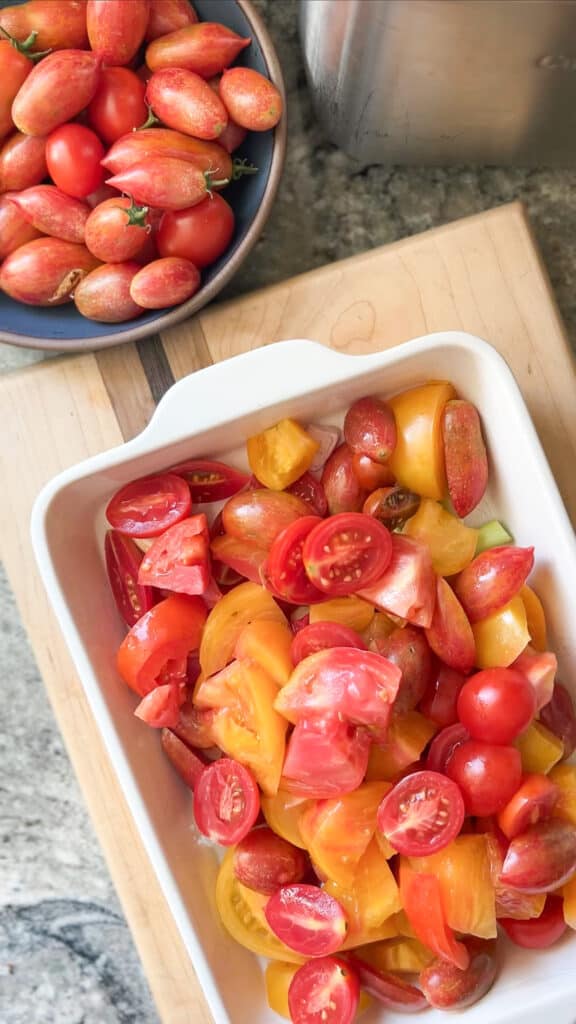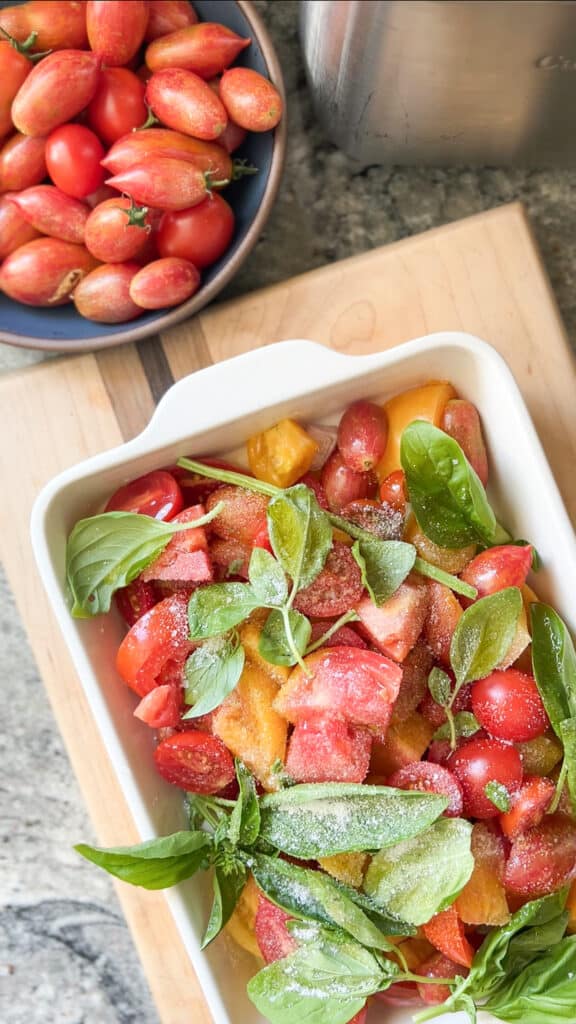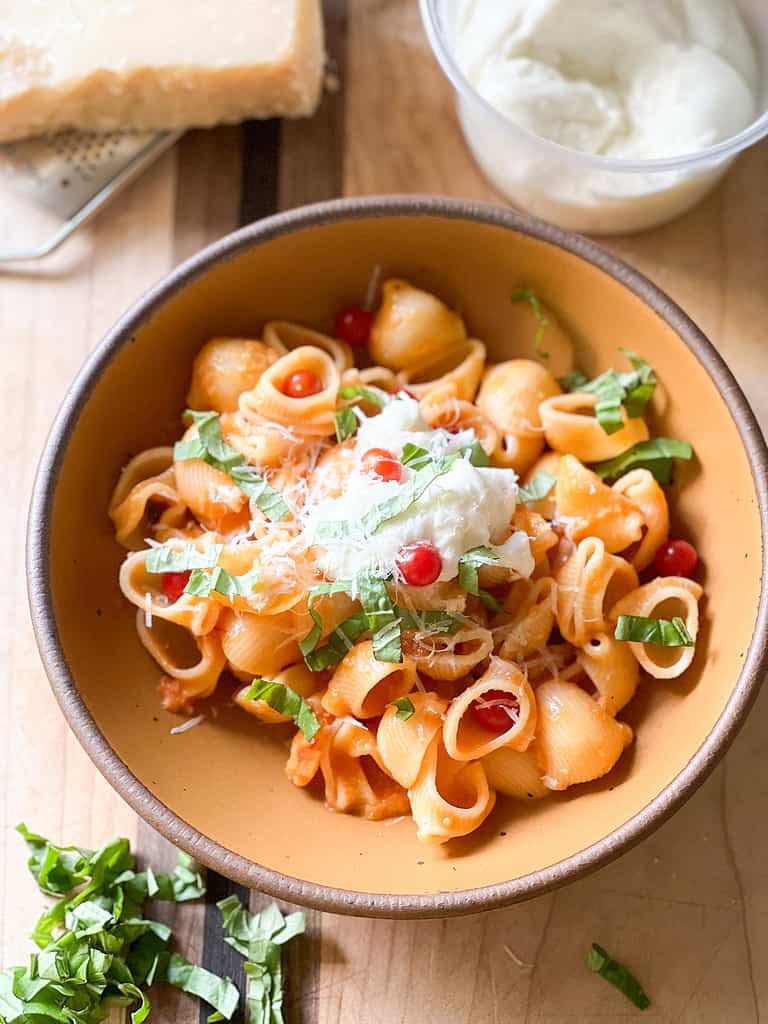When tomatoes make their way into our CSA box there are occasions when they are cracked or split. Two key things to note: there is a good explanation for why this happens and we can still enjoy them. Read on to learn why it happens and what you can do to ensure these don’t go to waste.
Tomato season is something we look forward to each summer. Vine ripened heirloom varieties make their triumphant return to our CSA box each summer giving us delicious recipes to enjoy at the right time. If we’re the canning type, we’ll likely take those tomato varieties and transform them into savory sauces to carry us through the winter months.
Whether you receive these types of tomatoes in your produce box or spy them at the farmers market, this post talks about why we will see a cracked tomato, the reason why tomatoes split, and what we can do as home cooks to make the most of them while reducing food waste.

Why Tomatoes Crack and Split
You’ve likely seen these at the farmers market, your produce box, or even at the grocery store this season. You may even see this in your own home-grown tomatoes. Small cracks that appear on the top of the fruit or seeing radial cracking from along the tomato skin. There are two big reasons why we see tomato fruits split or crack in the first place:
- Radical changes in moisture levels
- Sudden increase in hot temperature
During the growing season, a lot of rain due to heavy rainfall can lead to excess water for tomato plants. Couple that with contrasting periods of a dry spell or a sudden change in hot weather and the growth of the skin on the outer skin of the tomatoes cannot keep up with the rest of the fruit. This leads to cracking. You’ll likely see two types of cracks:
- Concentric cracks: this is where cracks form in a ring around the stem scar in the form of a circle.
- Radial Cracks: this is where the cracks begin to form at the stem end and progress along the blossoming fruit end.
What’s most fascinating to note about the types of vertical splits or concentric cracking we may see is that it gives us insight into the water fluctuations and abrupt changes in dry weather during the growth season.
As a consumer or CSA member, this insight helps us to understand what we see when this type of cracking occurs in the baskets of cherry tomatoes or heirloom varieties we receive in our weekly boxes. I am immediately thinking about the heavy periods of rain we had in Southern California this summer with contrasting dry heat and hot temperatures. It makes so much sense now!
What to Do With Cracked or Split Tomatoes
We may see vertical cracks or circular ones in our lovely summer tomatoes, but the good news is we can still use them. The best way to work with a tomato splitting is to use it right away. We can slice the tomato flesh around the cracks. We want to get as close to the visible crack as possible just to capture as much of our red tomatoes as possible. Avoid using the cracked areas of the tomato as they can harbor mold and bacteria. Since we don’t want that in the dishes we’re making let’s play it safe and cut around those areas of the tomato.
With the remaining scraps, we can toss those in the compost pile for our organic mulch or put in the green waste bin for waste management. The bottom line: even if we see a tomato cracking, we can still use them right away!


Putting Them to Use: Roasting Cracked or Split Tomatoes for Sauce
Now that we have removed the cracked or split parts of our tomatoes, let’s use them before they go to waste. I love a super simple roast tomato sauce using the heirloom varieties we get in our CSA box. There are different ways to roast them with a variety of ingredients but this robust tomato sauce is easy in approach and yields robust flavors. To make it:
- First thing, preheat your oven to 400 degrees. Add tomatoes to a ceramic baking dish. Depending on size, you can slice the tomatoes in half or quarters. Spread tomatoes in an even layer in baking dish (measuring about 9×13″). Drizzle with olive oil, and season with salt, pepper, and red pepper flakes.
- Layer your selected herbs. Think rosemary and thyme or fresh basil for summer. Add in a few cloves of garlic. Use as much garlic as you like! I like to use anywhere from 6 to 10 cloves for about 2 pounds of tomatoes. Roast tomatoes in oven for about 15 minutes until they are slightly blistered and soft.
- Once roasted, add all the basil, garlic, and tomatoes to a food processor or blender. Blend everything together until combined. Pour the sauce into a large skillet and simmer on low heat for 5 minutes to allow sauce to thicken slightly and flavors blend together. Add your cooked pasta and toss together to combine. Serve immediately garnishing with fresh parmesan and julienned basil. Alternatively, once blended you can place your sauce in freezer friendly containers and freeze for up to 6 months.


Savoring the Season: Recipes Using Roast Tomato Sauce
Roasting tomatoes for sauce is a simple way to use up our split or cracked tomatoes, whether we see them at the Farmers Market or receive them in our CSA box. Let’s still buy them and use them! And if you’re looking for an easy roast tomato recipe, my Robust Heirloom Tomato Sauce is one that’s super adaptable and delicious!
Have more questions about what to do with split or cracked tomatoes? Let me know in the comments! I’m always happy to answer them as we keep cooking with our CSA.


Your creative ideas for utilizing my “ugly” tomatoes are a game-changer! I never thought these slightly damaged ones could be transformed into such delicious dishes. Your tips helped me reduce my waste this week. Thank you for sharing these practical solutions!
So glad this was helpful! It’s amazing how much we can reduce our food waste with this simple and practical solutions. Appreciate you sharing!